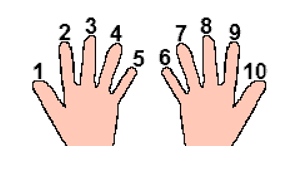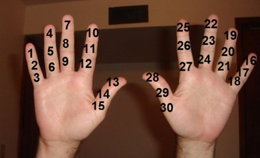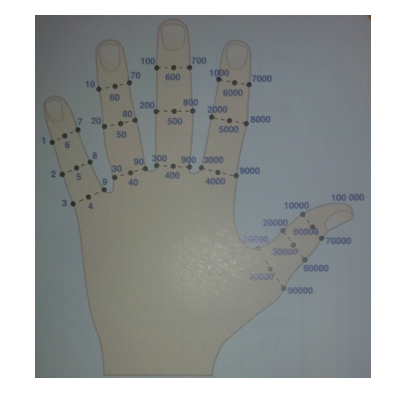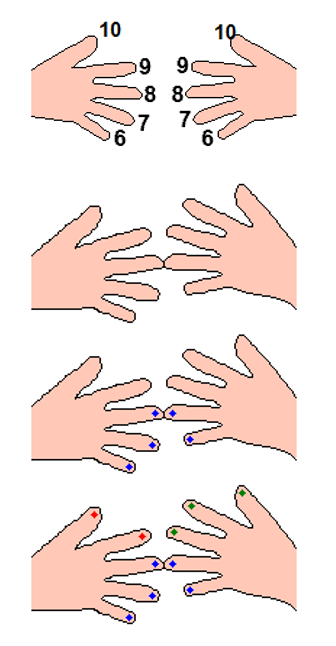Note: This is a guest post by Aditya Singhal.
Remember when your parents used to scold you for using fingers for math? And we used to picture fingers in our minds while tying our hands at our backs. Resisting to use fingers was tough then. Why do we still instruct students to not use fingers when we know that we ourselves couldn’t resist using this technique?
Because it’s the established convention?
Visual Learning
Think of it this way. As of late, the importance of using visuals in teaching has been on the rise. Schools have been adopting smart class techniques to educate students in a visual way because visuals have been proven to stick around in pupils’ minds for longer. A study even claims that the human mind interprets visuals 60,000 times faster than text. Learning through visuals has been a successful paradigm shift in the world of education.
First Forms of Visuals
Now, what makes you think that fingers are not forms of visuals? Mathematics is one of the most struggled with subjects, especially in the initial phase when we learn how to count. Using visuals for teaching math is definitely a way of making this phase a little easier to survive. Fingers are the most easily accessible forms of visuals we can incorporate in mathematics studies.
Allowing our students to use fingers not only encourages them to count but can also be instrumental in teaching basic addition. Science blogs finds fingers an alternative to the much-used abacus and explains how fingers can be used to teach simple addition.
However, there is something that restricts you from allowing your students to use this simple technique. What’s that?
The Debate around the Finger Technique
The use of fingers in math classes has always been discouraged by teachers. The finger technique is considered to be a less intelligent way of counting and calculating. Most adults think of it as a technique that might hamper the developments of the kid’s brain and consider it to be a childish trick which renders answers but does not help in understanding.
Many schools across the world have banned the use of fingers in math class and this is a matter of major concern because by doing this, we are confining the scope of development of our students’ brains.
Contradictory Theories
A recent study published by the US government suggests that “finger representation and finger-based strategies play an important role in learning and understanding arithmetic.” This study explains why we, as kids, used to see a mental representation of fingers while counting when we were restricted from using fingers.
Another study published by US government states that the benefits of using fingers in math are evident a year later. Students who have a good knowledge of fingers in the first grade perform better in number comparison in the second grade. It has been discovered that if a 6- year-old kid learns finger perception and is able to represent his fingers effectively, he/she turns out to be better in mathematics, especially in counting and putting the numbers in order.
Not just that, there has been concrete evidence from studies proving that when students are trained on finger perception and representation and they turn out to be good in it, it results in higher mathematical achievement. Neuroscientists suggest schools to teach students about finger discrimination.This is a breakthrough study that suggests that the finger technique is useful in kids’ cognitive development.
Further supporting the study above, a Stanford professor, Jo Boaler, also published a study supporting the finger representation technique. According to her research paper, there are neurological benefits of using fingers in math class. She claims that the use of fingers is key in teaching basic mathematics and results in higher mathematic IQ later on.
How to Calculate Using Fingers?
Nearly all kids learn how to count, and do simple addition and subtraction using their fingers. However, when they grow older, we discourage them to count on fingers, which is seen as a less intelligent way to think.
Here are some of the finger representation techniques that can be used to solve basic math problems.
Up to 10
We all know how to count up to 10 on fingers:

Up to 30
Many of us can count up to 30 using finger partitions:

Up to 99
Koreans use a method called Chisenbop Counting to count up to 99.
Put your hands on the table, palms down with thumbs towards each other – as if you are playing the piano. The fingers on the right hand represent the units, with the thumb representing number 5. The fingers on the left hand represent the tens, with the thumb representing number 50.
Here are some of the numbers represented in this manner:

Up to 10^10
An old Chinese method allows us to count up to 100,000 on one hand and up to 10,000,000,000 on two hands, touching the markers as required:

Multiplying by 6, 7, 8, 9 and 10

Hold your palms facing inwards, counting from bottom to top as 6 to 10. Now, touch the fingers of digits you want to multiply. Above, you can see finger number 8 touching finger number 7 to calculate 8×7.
Add the touching fingers and fingers below them. These are your tens. In the example, these add up to 5 (and will represent 50).
Now, multiply fingers on the left hand (above the touching fingers), with the fingers on the right hand (above the touching fingers). In the example, you will multiply 2×3 = 6.
Add the two, and you will get your answer (50+6 = 56).
Fingers as an Imaginary Abacus
See this video first:
These Indian kids use an old Asian technique where they use fingers as an imaginary abacus and operate it to perform more complex mathematical operations in just seconds.It takes
It takes time to master the technique but it has been found that even a visually impaired child can use it effectively. From multiplying strings of 10-digit numbers to finding the square root of a 6-digit number, the technique can help kids to do everything that we can do with an abacus. (The technique uses the Korean system of counting.)
UCMAS (Universal Concept Mental Arithmetic System) teaches this system. Started in 1993, it has a global network of more than 5,500 centres across 57 countries, and has trained millions of children already.Many leading universities such as Harvard, Stanford, University of California San Diego (UCSD), and
Many leading universities such as Harvard, Stanford, University of California San Diego (UCSD), and the University of Chicago in the USA; University of Khartoum in Sudan; and University of Manchester in the UK have researched the system– and have found it to be very helpful for children who are 4-13 years old.
Conclusion
You should not have any questions about incorporating highly worthwhile finger systems in your math class after exploring all these studies. Breaking the conventions isn’t easy but it is necessary at times. If you have come across this article, there shouldn’t be anything stopping you from taking this suggestion up and implementing it in your school.
Let’s take a step towards better education.
There used to be a time where I got laughed at doing multiplication by tracing the fingers, but what they are not aware of is that finger tracing — or other similar technique in mental arithmetic — involves both visual and tactile representations, and is hence multisensory and has synergistic effect on enhancing attention and combating short-term memory decay. While counting with fingers might be slow for adults, mental abacus/finger techniques are both fun and deceptively-powerful techniques to streamline calculations in general. Sure, there’s a learning curve, but it pays off big time.
Great! Counting up to 10.000.000.000 with just your 10 fingers even beats the “binary” method. You can represent a binary digit with each finger and thus count up to 2^(number of fingers) – 1 😉
That’s the approach I was used to for counting up to very large numbers with your fingers.
Brilliant synthesis. We’ve used finger tricks at the high school level to such success that the region feared we may have cheated in sections of our exams. It’s an incredibly valuable tool that, invaluably, tends to stick with students forever.
The concept of using fingers to count should be implemented, especially in grades K-2, when a child is just starting to learn math.
Unfortunately, young students are given a calculator to solve their math problems, thus they never learn the basics of arithmetic.
As a math tutor, my job is to make sure my students learn the basics when it comes to math. Using a visual tool such as fingers help young students get a grasp of the subject, which in turn will help them achieve success in higher levels of mathematics.
Thanks for the post.
I can’t imagine what the system for solving the square root for a triple-digit number would be like, let alone 6 digits! I’m fond of how inviting the approach is; especially for younger students. It promotes this feeling of freedom of exploring mathematics in the best way you see fit using whatever resources you have. It fosters a sense of ownership to the math involved which I feel is critical for students to further engage in the math they learn.
Brilliant Ive been looking at abacus work in schools in many schools as well seems the act of counting is really underpinning all learning and fingers and toes are accessible tools.
This is great. Thanks for sharing.
We will definitely use these techniques when we teach younger students.